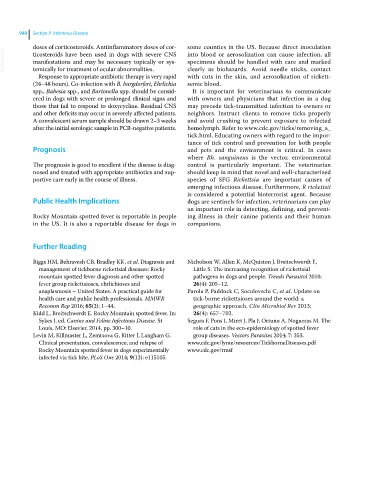Page 1002 - Clinical Small Animal Internal Medicine
P. 1002
940 Section 9 Infectious Disease
doses of corticosteroids. Antiinflammatory doses of cor- some counties in the US. Because direct inoculation
VetBooks.ir ticosteroids have been used in dogs with severe CNS into blood or aerosolization can cause infection, all
specimens should be handled with care and marked
manifestations and may be necessary topically or sys-
temically for treatment of ocular abnormalities.
with cuts in the skin, and aerosolization of rickett-
Response to appropriate antibiotic therapy is very rapid clearly as biohazards. Avoid needle sticks, contact
(24–48 hours). Co‐infection with B. burgdorferi, Ehrlichia semic blood.
spp., Babesia spp., and Bartonella spp. should be consid- It is important for veterinarians to communicate
ered in dogs with severe or prolonged clinical signs and with owners and physicians that infection in a dog
those that fail to respond to doxycycline. Residual CNS may precede tick‐transmitted infection to owners or
and other deficits may occur in severely affected patients. neighbors. Instruct clients to remove ticks properly
A convalescent serum sample should be drawn 2–3 weeks and avoid crushing to prevent exposure to infected
after the initial serologic sample in PCR‐negative patients. hemolymph. Refer to www.cdc.gov/ticks/removing_a_
tick.html. Educating owners with regard to the impor-
tance of tick control and prevention for both people
Prognosis and pets and the environment is critical. In cases
where Rh. sanguineus is the vector, environmental
The prognosis is good to excellent if the disease is diag- control is particularly important. The veterinarian
nosed and treated with appropriate antibiotics and sup- should keep in mind that novel and well‐characterized
portive care early in the course of illness. species of SFG Rickettsia are important causes of
emerging infectious disease. Furthermore, R rickettsii
is considered a potential bioterrorist agent. Because
Public Health Implications dogs are sentinels for infection, veterinarians can play
an important role in detecting, defining, and prevent-
Rocky Mountain spotted fever is reportable in people ing illness in their canine patients and their human
in the US. It is also a reportable disease for dogs in companions.
Further Reading
Biggs HM, Behravesh CB, Bradley KK, et al. Diagnosis and Nicholson W, Allen K, McQuiston J, Breitschwerdt E,
management of tickborne rickettsial diseases: Rocky Little S. The increasing recognition of rickettsial
mountain spotted fever diagnosis and other spotted pathogens in dogs and people. Trends Parasitol 2010;
fever group rickettsioses, ehrlichioses and 26(4): 205–12.
anaplasmosis – United States. A practical guide for Parola P, Paddock C, Socolovschi C, et al. Update on
health care and public health professionals. MMWR tick‐borne rickettsioses around the world: a
Recomm Rep 2016; 65(2): 1–44. geographic approach. Clin Microbiol Rev 2013;
Kidd L, Breitschwerdt E. Rocky Mountain spotted fever. In: 26(4): 657–702.
Sykes J, ed. Canine and Feline Infectious Disease. St Segura F, Pons I, Miret J, Pla J, Ortuno A, Nogueras M. The
Louis, MO: Elsevier, 2014, pp. 300–10. role of cats in the eco‐epidemiology of spotted fever
Levin M, Killmaster L, Zemtsova G, Ritter J, Langham G. group diseases. Vectors Parasites 2014; 7: 353.
Clinical presentation, convalescence, and relapse of www.cdc.gov/lyme/resources/TickborneDiseases.pdf
Rocky Mountain spotted fever in dogs experimentally www.cdc.gov/rmsf
infected via tick bite. PLoS One 2014; 9(12): e115105.

